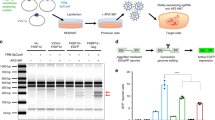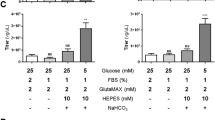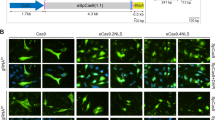Abstract
The mouse is widely used as a model for DNA therapy and vaccination even though the efficiency of DNA delivery in higher mammals and humans is much less. The human APOBEC3 (A3) enzymes impact viral genomes by cytidine deamination, which introduces multiple uridine residues into single-stranded DNA, a process known as genetic editing. This initiates rapid DNA catabolism via a uracil DNA glycosylase dependent pathway. In tissue culture, A3A, A3C and A3B can hyperedit transfected plasmid DNA. We explored plasmid catabolism in vivo initiated by A3A, the most efficient of the human enzymes and one that is functionally conserved across most mammals. As rodents do not encode an A3A enzyme, it was possible to explore DNA degradation in the mouse model. Human A3A genetically edits co-electroporated luciferase plasmid DNA in mouse skeletal muscle that initiates DNA degradation resulting in approximately fourfold decrease in bioluminescence. Part of the degradation occurs in the nucleus as indicated by complex hyperedited DNA molecules. As human A3A is strongly upregulated by interferon α and DNA sensing pathways, it is a strong candidate enzyme for restricting plasmid DNA in higher mammals.
This is a preview of subscription content, access via your institution
Access options
Subscribe to this journal
Receive 12 print issues and online access
$259.00 per year
only $21.58 per issue
Buy this article
- Purchase on Springer Link
- Instant access to full article PDF
Prices may be subject to local taxes which are calculated during checkout







Similar content being viewed by others
References
Faurez F, Dory D, Le Moigne V, Gravier R, Jestin A . Biosafety of DNA vaccines: New generation of DNA vectors and current knowledge on the fate of plasmids after injection. Vaccine 2010; 28: 3888–3895.
Gurunathan S, Klinman DM, Seder RA . DNA vaccines: immunology, application, and optimization. Annu Rev Immunol 2000; 18: 927–974.
Murakami T, Sunada Y . Plasmid DNA gene therapy by electroporation: principles and recent advances. Curr Gene Ther 2011; 11: 447–456.
Trollet C, Scherman D, Bigey P . Delivery of DNA into muscle for treating systemic diseases: advantages and challenges. Methods Mol Biol 2008; 423: 199–214.
Barry ME, Pinto-Gonzalez D, Orson FM, McKenzie GJ, Petry GR, Barry MA . Role of endogenous endonucleases and tissue site in transfection and CpG-mediated immune activation after naked DNA injection. Hum Gene Ther 1999; 10: 2461–2480.
Harris RS, Bishop KN, Sheehy AM, Craig HM, Petersen-Mahrt SK, Watt IN et al. DNA deamination mediates innate immunity to retroviral infection. Cell 2003; 113: 803–809.
Lecossier D, Bouchonnet F, Clavel F, Hance AJ . Hypermutation of HIV-1 DNA in the absence of the Vif protein. Science 2003; 300: 1112.
Mangeat B, Turelli P, Caron G, Friedli M, Perrin L, Trono D . Broad antiretroviral defence by human APOBEC3G through lethal editing of nascent reverse transcripts. Nature 2003; 424: 99–103.
Mariani R, Chen D, Schrofelbauer B, Navarro F, Konig R, Bollman B et al. Species-specific exclusion of APOBEC3G from HIV-1 virions by Vif. Cell 2003; 114: 21–31.
Suspène R, Sommer P, Henry M, Ferris S, Guétard D, Pochet S et al. APOBEC3G is a single-stranded DNA cytidine deaminase and functions independently of HIV reverse transcriptase. Nucleic Acids Res 2004; 32: 2421–2429.
Yu Q, Konig R, Pillai S, Chiles K, Kearney M, Palmer S et al. Single-strand specificity of APOBEC3G accounts for minus-strand deamination of the HIV genome. Nat Struct Mol Biol 2004; 11: 435–442.
Zhang H, Yang B, Pomerantz RJ, Zhang C, Arunachalam SC, Gao L . The cytidine deaminase CEM15 induces hypermutation in newly synthesized HIV-1 DNA. Nature 2003; 424: 94–98.
Mann CJ, Anguela XM, Montane J, Obach M, Roca C, Ruzo A et al. Molecular signature of the immune and tissue response to non-coding plasmid DNA in skeletal muscle after electrotransfer. Gene Therapy 2012; 19: 1177–1186.
Roos AK, Eriksson F, Timmons JA, Gerhardt J, Nyman U, Gudmundsdotter L et al. Skin electroporation: effects on transgene expression, DNA persistence and local tissue environment. PLoS One 2009; 4: e7226.
Chester A, Weinreb V, Carter Jr CW, Navaratnam N . Optimization of apolipoprotein B mRNA editing by APOBEC1 apoenzyme and the role of its auxiliary factor, ACF. RNA 2004; 10: 1399–1411.
Petit V, Guétard D, Renard M, Keriel A, Sitbon M, Wain-Hobson S et al. Murine APOBEC1 is a powerful mutator of retroviral and cellular RNA in vitro and in vivo. J Mol Biol 2009; 385: 65–78.
Renard M, Henry M, Guétard D, Vartanian JP, Wain-Hobson S . APOBEC1 and APOBEC3 cytidine deaminases as restriction factors for hepadnaviral genomes in non-humans in vivo. J Mol Biol 2010; 400: 323–334.
Caval V, Suspène R, Vartanian JP, Wain-Hobson S . Orthologous mammalian APOBEC3A cytidine deaminases hypermutate nuclear DNA. Mol Biol Evol 2014; 31: 330–340.
Jarmuz A, Chester A, Bayliss J, Gisbourne J, Dunham I, Scott J et al. An anthropoid-specific locus of orphan C to U RNA-editing enzymes on chromosome 22. Genomics 2002; 79: 285–296.
LaRue RS, Jonsson SR, Silverstein KA, Lajoie M, Bertrand D, El-Mabrouk N et al. The artiodactyl APOBEC3 innate immune repertoire shows evidence for a multi-functional domain organization that existed in the ancestor of placental mammals. BMC Mol Biol 2008; 9: 104.
Suspène R, Aynaud M, Guétard D, Henry M, Eckhoff G, Marchio A et al. Somatic hypermutation of human mitochondrial and nuclear DNA by APOBEC3 cytidine deaminases, a pathway for DNA catabolism. Proc Natl Acad Sci USA 2011; 108: 4858–4863.
Alexandrov LB, Nik-Zainal S, Wedge DC, Aparicio SA, Behjati S, Biankin AV et al. Signatures of mutational processes in human cancer. Nature 2013; 500: 415–421.
Nik-Zainal S, Alexandrov LB, Wedge DC, Van Loo P, Greenman CD, Raine K et al. Mutational Processes Molding the Genomes of 21 Breast Cancers. Cell 2012; 149: 979–993.
Stenglein MD, Burns MB, Li M, Lengyel J, Harris RS . APOBEC3 proteins mediate the clearance of foreign DNA from human cells. Nat Struct Mol Biol 2010; 17: 222–229.
Vartanian JP, Guétard D, Henry M, Wain-Hobson S . Evidence for editing of human papillomavirus DNA by APOBEC3 in benign and precancerous lesions. Science 2008; 320: 230–233.
Lindahl T, Ljungquist S, Siegert W, Nyberg B, Sperens B . DNA N-glycosidases: properties of uracil-DNA glycosidase from Escherichia coli. J Biol Chem 1977; 252: 3286–3294.
Stivers JT, Pankiewicz KW, Watanabe KA . Kinetic mechanism of damage site recognition and uracil flipping by Escherichia coli uracil DNA glycosylase. Biochemistry 1999; 38: 952–963.
Chen H, Lilley CE, Yu Q, Lee DV, Chou J, Narvaiza I et al. APOBEC3A is a potent inhibitor of adeno-associated virus and retrotransposons. Curr Biol 2006; 16: 480–485.
Delebecque F, Suspène R, Calattini S, Casartelli N, Saib A, Froment A et al. Restriction of foamy viruses by APOBEC cytidine deaminases. J Virol 2006; 80: 605–614.
Mahieux R, Suspène R, Delebecque F, Henry M, Schwartz O, Wain-Hobson S et al. Extensive editing of a small fraction of human T-cell leukemia virus type 1 genomes by four APOBEC3 cytidine deaminases. J Gen Virol 2005; 86: 2489–2494.
Noguchi C, Ishino H, Tsuge M, Fujimoto Y, Imamura M, Takahashi S et al. G to A hypermutation of hepatitis B virus. Hepatology 2005; 41: 626–633.
Sheehy AM, Gaddis NC, Choi JD, Malim MH . Isolation of a human gene that inhibits HIV-1 infection and is suppressed by the viral Vif protein. Nature 2002; 418: 646–650.
Suspène R, Aynaud MM, Koch S, Pasdeloup D, Labetoulle M, Gaertner B et al. Genetic editing of herpes simplex virus 1 and Epstein-Barr herpesvirus genomes by human APOBEC3 cytidine deaminases in culture and in vivo. J Virol 2011; 85: 7594–7602.
Suspène R, Guétard D, Henry M, Sommer P, Wain-Hobson S, Vartanian JP . Extensive editing of both hepatitis B virus DNA strands by APOBEC3 cytidine deaminases in vitro and in vivo. Proc Natl Acad Sci USA 2005; 102: 8321–8326.
Tsuge M, Noguchi C, Akiyama R, Matsushita M, Kunihiro K, Tanaka S et al. G to A hypermutation of TT virus. Virus Res 2010; 149: 211–216.
Turelli P, Mangeat B, Jost S, Vianin S, Trono D . Inhibition of hepatitis B virus replication by APOBEC3G. Science 2004; 303: 1829.
Vartanian JP, Henry M, Marchio A, Suspène R, Aynaud MM, Guetard D et al. Massive APOBEC3 editing of hepatitis B viral DNA in cirrhosis. PLoS Pathog 2010; 6: e1000928.
Shinohara M, Io K, Shindo K, Matsui M, Sakamoto T, Tada K et al. APOBEC3B can impair genomic stability by inducing base substitutions in genomic DNA in human cells. Sci Rep 2012; 2: 806.
Burns MB, Lackey L, Carpenter MA, Rathore A, Land AM, Leonard B et al. APOBEC3B is an enzymatic source of mutation in breast cancer. Nature 2013; 494: 366–370.
Carpenter MA, Li M, Rathore A, Lackey L, Law EK, Land AM et al. Methylcytosine and Normal Cytosine Deamination by the Foreign DNA Restriction Enzyme APOBEC3A. J Biol Chem 2012; 287: 34801–34808.
Wijesinghe P, Bhagwat AS . Efficient deamination of 5-methylcytosines in DNA by human APOBEC3A, but not by AID or APOBEC3G. Nucleic Acids Res 2012; 40: 9206–9217.
Landry S, Narvaiza I, Linfesty DC, Weitzman MD . APOBEC3A can activate the DNA damage response and cause cell-cycle arrest. EMBO Rep 2011; 12: 444–450.
Mussil B, Suspène R, Aynaud MM, Gauvrit A, Vartanian JP, Wain-Hobson S . Human APOBEC3A Isoforms Translocate to the Nucleus and Induce DNA Double Strand Breaks Leading to Cell Stress and Death. PLoS One 2013; 8: e73641.
Beale RC, Petersen-Mahrt SK, Watt IN, Harris RS, Rada C, Neuberger MS . Comparison of the differential context-dependence of DNA deamination by APOBEC enzymes: correlation with mutation spectra in vivo. J Mol Biol 2004; 337: 585–596.
Ebrahimi D, Alinejad-Rokny H, Davenport MP . Insights into the motif preference of APOBEC3 enzymes. PLoS One 2014; 9: e87679.
Henry M, Guétard D, Suspène R, Rusniok C, Wain-Hobson S, Vartanian JP . Genetic editing of HBV DNA by monodomain human APOBEC3 cytidine deaminases and the recombinant nature of APOBEC3G. PLoS One 2009; 4: e4277.
Koning FA, Newman EN, Kim EY, Kunstman KJ, Wolinsky SM, Malim MH . Defining APOBEC3 expression patterns in human tissues and hematopoietic cell subsets. J Virol 2009; 83: 9474–9485.
Refsland EW, Stenglein MD, Shindo K, Albin JS, Brown WL, Harris RS . Quantitative profiling of the full APOBEC3 mRNA repertoire in lymphocytes and tissues: implications for HIV-1 restriction. Nucleic Acids Res 2010; 38: 4274–4284.
Burns MB, Temiz NA, Harris RS . Evidence for APOBEC3B mutagenesis in multiple human cancers. Nat Genet 2013; 45: 977–983.
Stephens PJ, Tarpey PS, Davies H, Van Loo P, Greenman C, Wedge DC et al. The landscape of cancer genes and mutational processes in breast cancer. Nature 2012; 486: 400–404.
Wang Z, Mosbaugh DW . Uracil-DNA glycosylase inhibitor of bacteriophage PBS2: cloning and effects of expression of the inhibitor gene in Escherichia coli. J Bacteriol 1988; 170: 1082–1091.
Rettig GR, McAnuff M, Liu D, Kim JS, Rice KG . Quantitative bioluminescence imaging of transgene expression in vivo. Anal Biochem 2006; 355: 90–94.
Suspène R, Henry M, Guillot S, Wain-Hobson S, Vartanian JP . Recovery of APOBEC3-edited human immunodeficiency virus G->A hypermutants by differential DNA denaturation PCR. J Gen Virol 2005; 86: 125–129.
Harris RS, Liddament MT . Retroviral restriction by APOBEC proteins. Nat Rev Immunol 2004; 4: 868–877.
Aynaud MM, Suspène R, Vidalain PO, Mussil B, Guétard D, Tangy F et al. Human Tribbles 3 protects nuclear DNA from cytidine deamination by APOBEC3A. J Biol Chem 2012; 287: 39182–39192.
Liu J, Wu X, Franklin JL, Messina JL, Hill HS, Moellering DR et al. Mammalian Tribbles homolog 3 impairs insulin action in skeletal muscle: role in glucose-induced insulin resistance. Am J of Physiol Endocrinol Metab 2010; 298: E565–E576.
Suspène R, Caval V, Henry M, Bouzidi MS, Wain-Hobson S, Vartanian JP . Erroneous identification of APOBEC3-edited chromosomal DNA in cancer genomics. Br J Cancer 2014; 110: 2615–2622.
Gehl J . Electroporation for drug and gene delivery in the clinic: doctors go electric. Methods Mol Biol 2008; 423: 351–359.
Mir LM, Bureau MF, Gehl J, Rangara R, Rouy D, Caillaud JM et al. High-efficiency gene transfer into skeletal muscle mediated by electric pulses. Proc Natl Acad Sci USA 1999; 96: 4262–4267.
Mir LM, Moller PH, Andre F, Gehl J . Electric pulse-mediated gene delivery to various animal tissues. Adv Genet 2005; 54: 83–114.
Acknowledgements
This work was supported by grants from Institut Pasteur and Invectys. Marie Escande for technical support in tissue dissection.
Author information
Authors and Affiliations
Corresponding author
Ethics declarations
Competing interests
PLD and SWH are co-founders of Invectys, a biotech devoted to therapeutic cancer vaccination. The remaining authors declare no conflict of interest.
Additional information
Supplementary Information accompanies this paper on Gene Therapy website
Supplementary information
Rights and permissions
About this article
Cite this article
Kostrzak, A., Henry, M., Demoyen, P. et al. APOBEC3A catabolism of electroporated plasmid DNA in mouse muscle. Gene Ther 22, 96–103 (2015). https://doi.org/10.1038/gt.2014.88
Received:
Revised:
Accepted:
Published:
Issue Date:
DOI: https://doi.org/10.1038/gt.2014.88
This article is cited by
-
APOBEC3B, a molecular driver of mutagenesis in human cancers
Cell & Bioscience (2017)
-
APOBEC3A intratumoral DNA electroporation in mice
Gene Therapy (2017)
-
Modulating APOBEC expression enhances DNA vaccine immunogenicity
Immunology & Cell Biology (2015)



